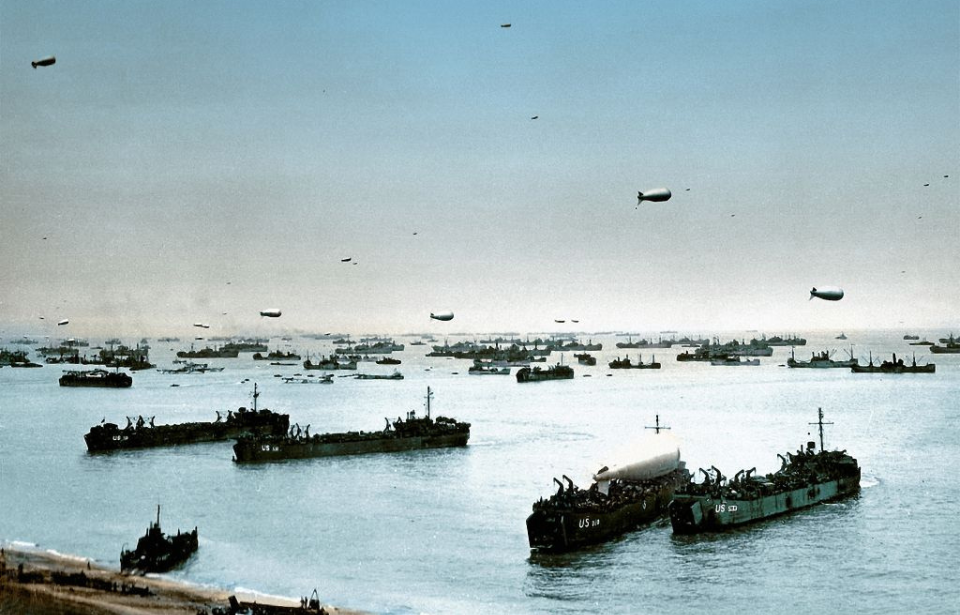On June 6, 1944, the Allies launched their largest-ever amphibious assault, landing on five beaches and in strategic zones behind enemy lines. This operation successfully breached German defenses in France, liberating the country from occupation. Known famously as D-Day or Operation Overlord, this crucial event marked a key turning point towards the end of World War II in Europe.
Preparations for this monumental invasion began over a year prior, shrouded in the utmost secrecy. The Allies carefully planned deceptive maneuvers, such as Operation Copperhead, to confound the enemy. These strategies proved highly effective, ensuring the landings encountered minimal resistance.
By late 1944 and early 1945, Allied forces had made substantial gains across France, Germany, Belgium, and the Netherlands, steadily advancing towards the liberation of Europe.
Intense preparations
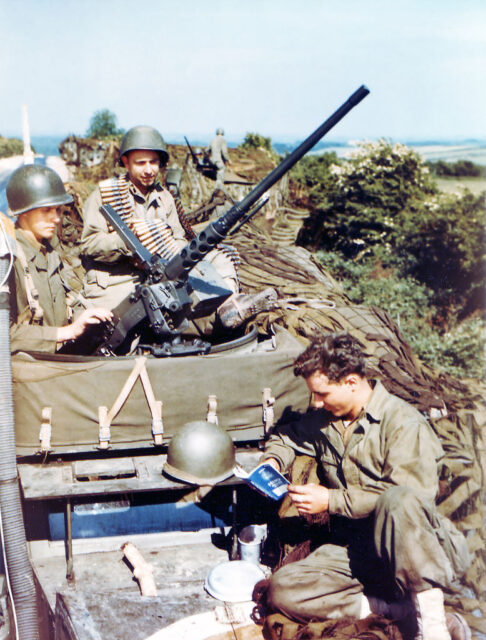
A lot of waiting and sitting around

American troops wait in their landing craft in Weymouth, United Kingdom, anticipating the start of the Normandy invasion. Weymouth was one of several launching points from which the Allied forces crossed the English Channel.
Crucial footage

Capt. Dale Elkins, shown in this photograph, was the first to capture images of the D-Day landings. Employing a specially designed camera, he documented these important moments.
Pointe du Hoc

Members of the US Army Provisional Ranger Group use their GN-45 hand crank generator to power their radio during the assault of Pointe du Hoc. They were tasked with capturing the lookout point, which served as a stronghold of German guns, after scaling the cliffs from the water below.
‘Into the Jaws of Death’
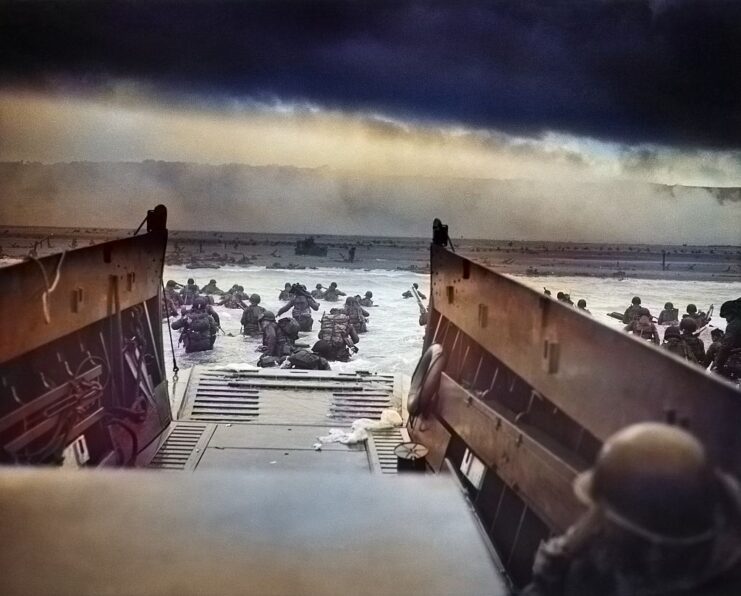
This photo was taken by CPO. Robert F. Sargent of the US Coast Guard. Titled “Into the Jaws of Death,” it shows members of Company E, 16th Infantry Regiment, 1st Infantry Division disembarking from a landing craft at Omaha Beach.
Most notably, this image was brought to life in 1998’s Saving Private Ryan.
Looking for Omaha Beach
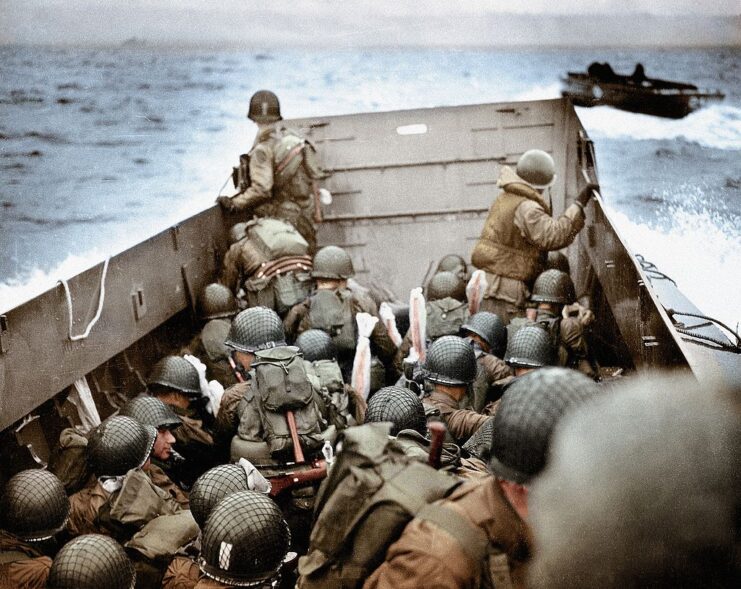
Also taken by CPO. Sargent, this photo shows American soldiers with their weapons wrapped in Pliofilm. This material was used to prevent the rifles and guns from getting wet as the troops made their way to the landing beaches.
It’s believed these men were landing near Saint-Laurent-sur-Mer, one of the towns near Omaha Beach.
Landing craft lineup
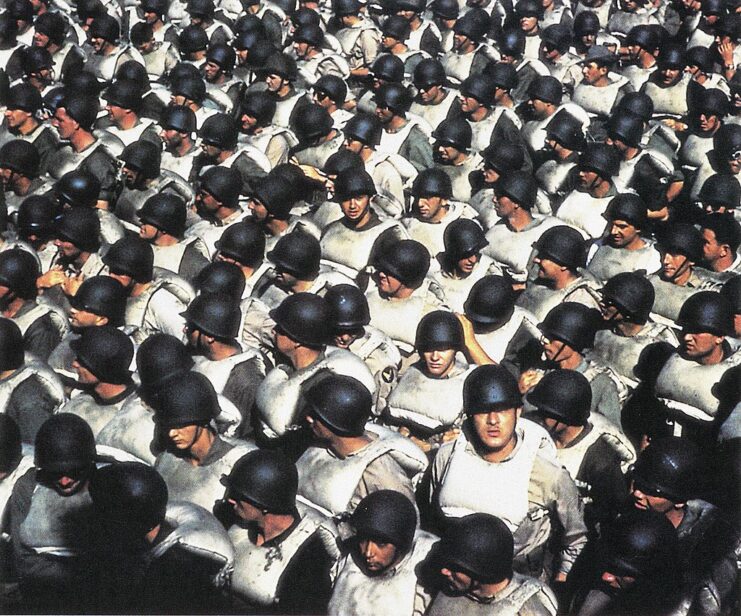
American soldiers aboard a landing craft as it approaches the landing beaches. Each can be seen wearing helmets and life vests, ready to disembark when they get close enough.
A little help from a friend

American soldiers serving with the 116th Infantry Regiment, 29th Infantry Division help their comrades out of the water and onto the beach. Their landing craft was sunk before they reached ground, forcing the soldiers to swim to their target. This can be seen as an omen for how D-Day would go for the regiment, as it suffered heavy casualties during the Allied landings.
The only identifiable soldier is Pfc. Nicholas Russin, third from the right.
American horsepower
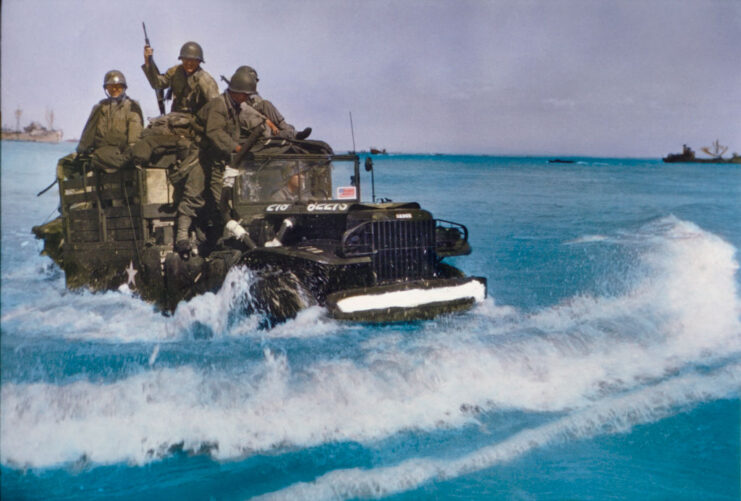
These American soldiers were much better off than their comrades in the sunken landing craft. They charged through the water on a military Jeep, toward the Normandy shore.
A temporary harbor

After successfully landing on the beaches, American troops established temporary, floating docks for the disembarkment of future vessels. Shown here are US vehicles traveling from Temporary Mulberry Harbor A to Omaha Beach, across Pontoon Bridge, on June 16, 1944.
Bring on the bombers

It was important that ground troops be provided with air cover during the invasion. The 344th Bombardment Group (Medium), shown here, led the IX Bomber Command formation that did so. They bombed targets in the Falaise Gap, Saint-Lô, Caen and the Cotentin Peninsula.
Enter the Canadians

Men with the 3rd Canadian Infantry Division landed in the Bernières-sur-Mer segment of Juno Beach. In this photo, they can be seen bringing various materials ashore from different landing craft.
Man the guns
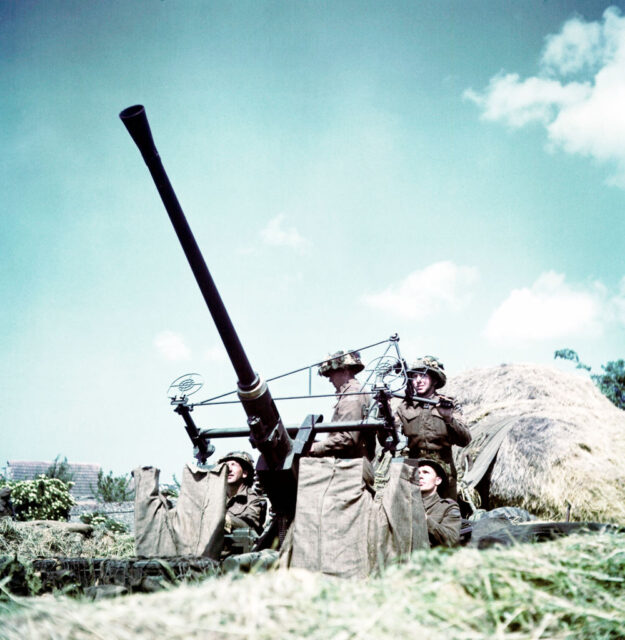
Soldiers with the 3rd Canadian Infantry Division man a Bofors 40 mm anti-aircraft gun as they keep a lookout for Luftwaffe aircraft. These men came ashore at Juno Beach on D-Day and established their encampment near Bernières-sur-Mer.
Asking for directions
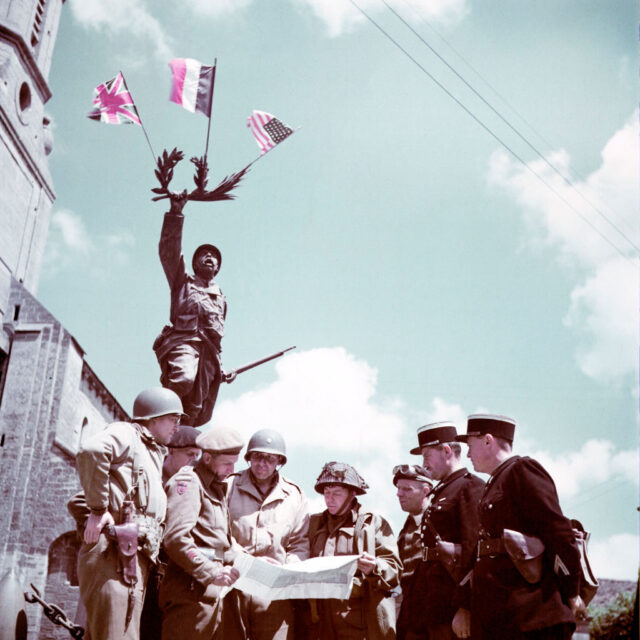
From left to right is Canadian war correspondent Charles B. Lynch; an unknown man in a black beret; Capt. Colin C. McDougall with the 21st Army Group; Lt. Col. George Stevens; Canadian photographer Lt. Frank L. Dubervill; and another unknown soldier looking over a map with the help of French policemen in the town of Creully.
The monument in the background was dedicated to the town’s dead from the First World War.
Letters from home
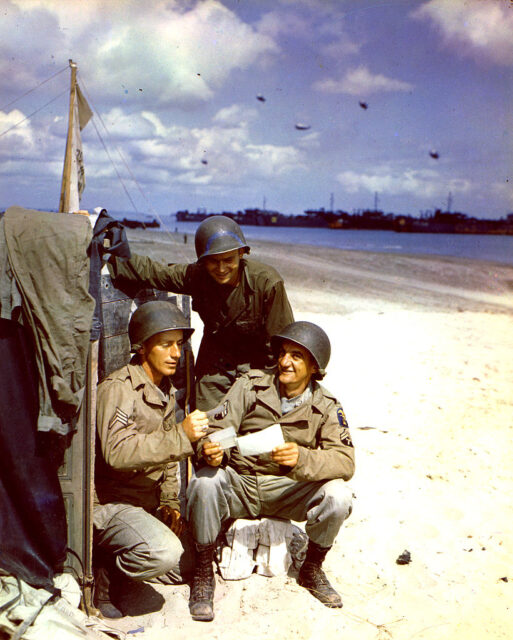
Sgt. R.A Forbis, Pvt. John Krisa and Cpl. V.E. Holtz of the US Army Corps of Engineers read letters just a few days after the D-Day landings.
A little rest

In need of a well-deserved rest, these American paratroopers rest during the Battle of Carentan, which lasted from June 6-13, 1944. The airborne troops were tasked with creating a single defensive line between Omaha and Utah Beaches.
Some of the men sit against the town buildings, while others congregate around a captured German military vehicle
Hose ‘er down

An American soldier tries to extinguish the flames engulfing a Republic P-47 Thunderbolt, which lies on the ground in the Cotentin Peninsula. The fighting in this region waged until June 20, 1944, as the Allies tried to gain control of the Port of Cherbourg.
Capture of Cherbourg
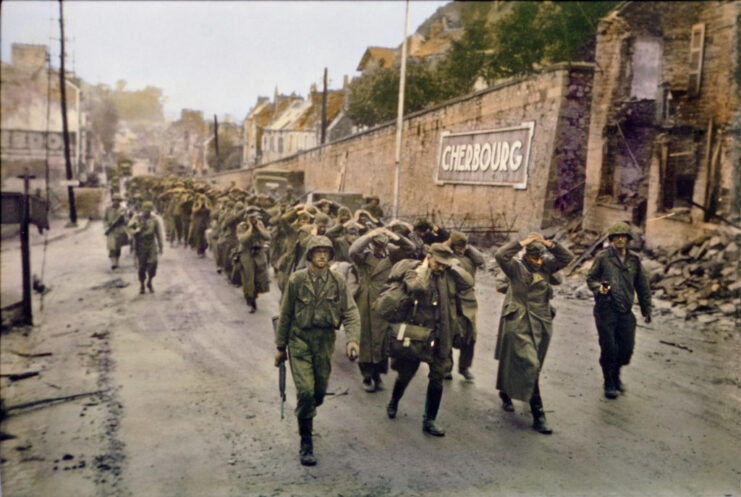
The Americans had successfully captured Cherbourg by June 25, 1944. While they rounded up numerous German soldiers, they also suffered heavy losses of their own. It was the first French port liberated by the Americans and one of the most important targets following D-Day.
Here, American troops march some of the German prisoners of war (POWs) down the city’s streets.
Enemy prisoners of war (POWs)

During the invasion of Normandy, Allied soldiers took thousands of POWs. These German soldiers were all captured in June 1944 and placed in a makeshift camp behind barbed wire.
A visit from Winston Churchill and Bernard Montgomery

British Prime Minister Winston Churchill and Gen. Sir Bernard Montgomery inspect the 50th (Northumbrian) Infantry Division in Caen. These men were one of two British divisions to land on Gold Beach on D-Day.
More men from the 50th earned Victoria Crosses during this operation than any other in the British Army during World War II.
Tending to the wounded

After the immediate fighting on the landing beaches concluded, it was time for the Allies to tend to their wounded. This image shows a group of 15 injured soldiers on the deck of the ship being looked after by doctors and nurses.
Battle of Saint-Lô
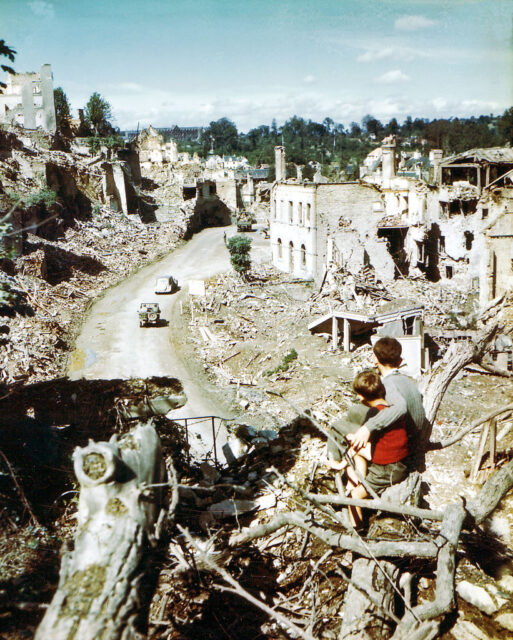
Two children stand in the ruins of Saint-Lô in August 1944, just one of the many places where fighting took place in the months following D-Day. It was one of the three engagements that made up the Battle of the Hedgerows, and the Americans targeted the town, engaging German troops between July 7-19, 1944.
Want War History Online‘s content sent directly to your inbox? Sign up for our newsletter here!
Although the area was of strategic importance to the Allies, upwards of 95 percent of the city was destroyed. On top of this, many civilian and military casualties were suffered.
